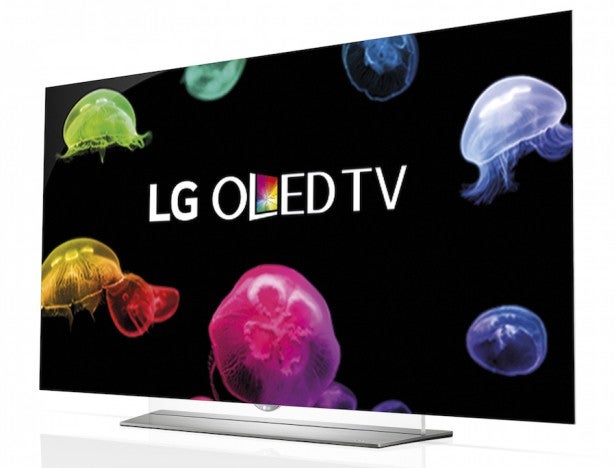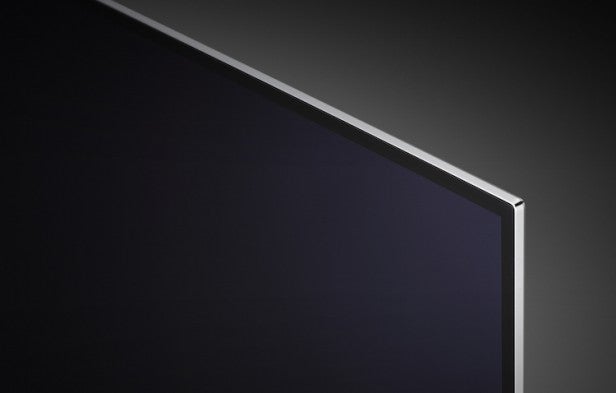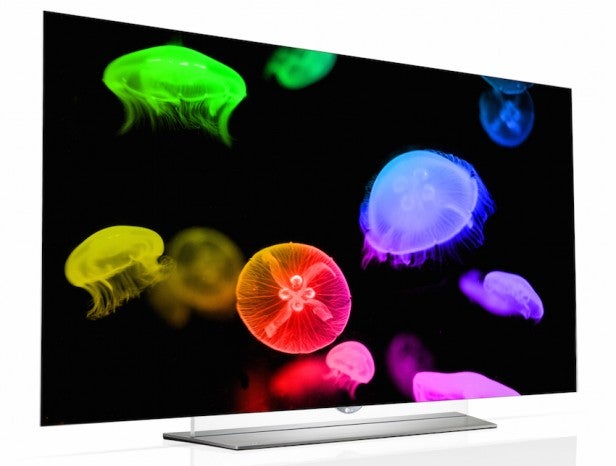LG 65EF950V Review - Picture Quality Review
Picture Quality
LG's first flat OLED TV flirts with perfection

Sections
- Page 1 LG 65EF950V Review
- Page 2 Picture Quality Review
- Page 3 Sound, 3D and Conclusions Review
LG 65EF950V – Picture Quality
The 65EF950V’s pictures essentially comprise a hell of a lot of ‘wow’ and just a little bit of ‘grrr’.
The wow department is led out by the TV’s magnificent black level performance (so long as you stick within the brightness ‘rules’ described in the previous section). Dark scenes I’ve watched a zillion times as part of my past TV reviewing duties took on new life. This is thanks to the 65EF950V’s incredibly inky and rich but also gorgeously natural and unforced blacks. The impact of the blacks is emphasised by the way they’re able to appear right alongside fearsomely bright parts of the picture. The combination gives pictures a level of intensity and dynamism no LCD TV can get close to matching.
If you’ve never had the chance to see OLED’s contrast performance in action before, your first reaction on seeing scenes containing a mix of very light and dark content on the 65EF950V may be simply ‘Why does LCD even bother any more?”.
Plasma screens offered the same sort of pixel-level lighting that OLED can. But for me not even the most awesome plasma screens were able to control the power going to their pixels with enough accuracy to deliver the same sort of blackness OLED can. And they certainly couldn’t deliver the same degree of colour vibrancy amid the blackness, especially in a bright room environment.
The 65EF950V’s colour handling really is lovely. It doesn’t stretch as far in its range as the best of this year’s Samsung and Sony UHD TVs, but it’s packed with the sort of nuances that really help unlock the power of a native 4K UHD resolution. My 4K test material – particularly scenes containing a mix of dark and bright image elements – has never looked better than it does on the 65EF950V.
The benefits of OLED’s self-emissive nature also help the colour resolution and vibrancy hold up superbly well in dark areas of the picture versus the majority of LCD TVs.
Another awesome benefit of the 65EF950V’s OLED technology is the picture’s complete freedom from the sort of backlight clouding issues that effect even the most outstanding LCD TVs from time to time.
Since each pixel makes its own light rather than an external light being shared between multiple pixels, you just don’t get problems like haloing (a characteristic of direct-lit LCD TVs) or light blocks (a characteristic of edge-lit LCD TVs) around bright objects when they appear against dark backgrounds. Nor are there any jets of light seepage to worry about in the screen’s corners, or general clouds of unrequired brightness hanging over parts of dark scenes.
The resulting purity and consistency of dark scenes is a joy to behold, and lets you engage much more fully with what you’re watching. Serious movie fans still traumatised by the loss of plasma will be in seventh heaven.
OLED’s self-emissive nature enables its pictures to be watched from much wider angles than is possible with LCD before contrast and colour saturation take a significant hit. Viewing angles are further boosted by the use of a flat rather than curved screen.
The 65EF950V’s flat screen also doesn’t distort onscreen reflections like LG’s curved OLEDs do. That’s not to say the screen isn’t still a touch more reflective than I’d like, especially given that reflections can be slightly emphasised by the screen’s stunning black level performance. But it’s still a marked improvement over LG’s curved EG960V OLED models.
One final ‘wow’ aspect of the 65EF950V’s pictures is how unexpectedly punchy they look. Whites and vibrant colours enjoy more vibrancy and pop than I expected and working in tandem with those mesmerising black levels produce an awesome sense of contrast.
Does the 65EF950V reach the same brightness levels of the leading LCD TVs like Samsung’s JS9500 and JS9000s or Sony’s X9305 models this year? No it doesn’t. Not even close. But having a more profound black level ensures that pictures still feel like they’ve got a truly ‘next gen’ dynamic range. It’s just that the foundation point for that dynamism lies at the black end of the luminance spectrum rather than the bright end.
A screen as supremely talented as the 65EF950V clearly deserves to be fed as much native 4K material as you can lay your hands on. But given that such material remains in frustratingly short supply – especially if you’re not signed up to the Amazon and Netflix video streaming platforms – you will find yourself watching upscaled HD most of the time.
Luckily the 65EF950V’s 4K UHD upscaling engine is pretty strong, adding detail without emphasising noise. The upscaling engines of Samsung, Panasonic and Sony deliver even sharper results, but the 65EF950V does well enough not to make watching HD rather than UHD feel like too painful a compromise.
The 65EF950V’s performance with the new high dynamic range picture technology just arriving in the TV world is fascinating, awesome, confusing and slightly disappointing in equal measure. It delivered wildly different levels of picture quality with each of the three HDR sources available to me – a result that makes it hard to know where the TV’s strengths and weaknesses lie.
With LG’s home-produced HDR content (a short travelogue with a mix of dark interiors and bright exterior shots, plus a highly staged, dramatically lit high-tech jazz performance) the 65EF950V’s picture quality is mostly incredible.
The expanded range between the luminance peaks and profound blacks makes for a gorgeously dynamic and involving picture that appears to prove that rumours of OLED’s inability to handle HDR don’t add up. It’s just that it delivers a different flavour/taste of HDR, based on stretching the light spectrum from a position of unprecedented black levels to higher-than-SDR peak brightness levels, versus the LCD approach of delivering much more extreme peak brightness levels but not reaching down to such extreme black level depths.
With my other two HDR content sources, though – Samsung-sourced clips from Exodus: Gods And Kings and Life Of Pi, and Amazon’s streams of the first series of Mozart In The Jungle – the 65EF950V looked far less comfortable. During the tests it’s stellar black level performance seems to desert it, leaving dark areas strikingly washed out and grey.
With the Samsung-sourced content this could be because the material was mastered to suit that brand’s ultra-bright SUHD HDR TVs – just as the LG content may well have been mastered to suit its OLED TVs. This argument is less easy to apply to the more ‘independent’ Amazon content – though it should also be said that the Amazon HDR streams look a bit washed out on every TV I’ve been able to watch them on.
Either way, the tests do help highlight a couple of issues with the 65EF950V’s pictures.
First, over time I became aware of a clear reduction in brightness at the left and right edges of the picture. This isn’t always visible, and its obviousness reduces if you restrict the screen’s brightness to below its 50 setting. But it can and does create a subtle vignetting effect that at times you can’t help but find yourself starting to look for.
LG’s curved OLED TVs have shown the same problem, along with some strange ‘bands’ of reduced brightness that step down in intensity from the centre of the screen to the outer edges. Happily this banding effect is greatly reduced on the 65EF950V, so the dimming issue only occurs on the screen’s extreme edges. But it’s still a really curious issue to find on a self-emissive screen technology.
The other issue with the 65EF950V’s mostly phenomenal pictures is that their trademark black level performance suddenly takes a fairly dramatic hit if you raise the brightness level too far. If you push the 65EF950V’s brightness up a few notches from its likely 50-52 default position you will suddenly see the inky blacks invaded by a very distinct grey wash that actually looks worse than the black level performance of good LCD TVs.
Of course, you can run the screen at a lower brightness to limit the potential for these sudden black level ‘jumps’ to appear. But not everyone will feel comfortable with this given OLED’s relatively low-brightness starting point versus LCD, and the way some subtle shadow detail can start to be crushed out if you reduce brightness from its default levels.
When watching HDR you’re actually locked out from adjusting various elements of the picture set up, including brightness. So if an HDR source ends up pushing the 65EF950V to a brightness point beyond its comfort zone the sudden grey wash can appear in the picture without you being able to do much about it. This even happens on a couple of occasions in LG’s own OLED-favouring HDR footage.
One other slight issue with the 65EF950V’s pictures is that motion can look a little uncomfortable in its native, unprocessed state. LG’s TruMotion system can cause a few obvious distracting processing artefacts, at least with very fast motion and camera pans. For the most part using the TruMotion system on its Clear setting delivers a workable balance of judder-reduction and processing side efects.
But, despite all these issues for the vast majority of our my testing time the 65EF950V presented jaw-dropping pictures that are truly the stuff of home cinema dreams.
How we test televisions
We test every TV we review thoroughly over an extended period of time. We use industry standard tests to compare features properly. We’ll always tell you what we find. We never, ever, accept money to review a product.

